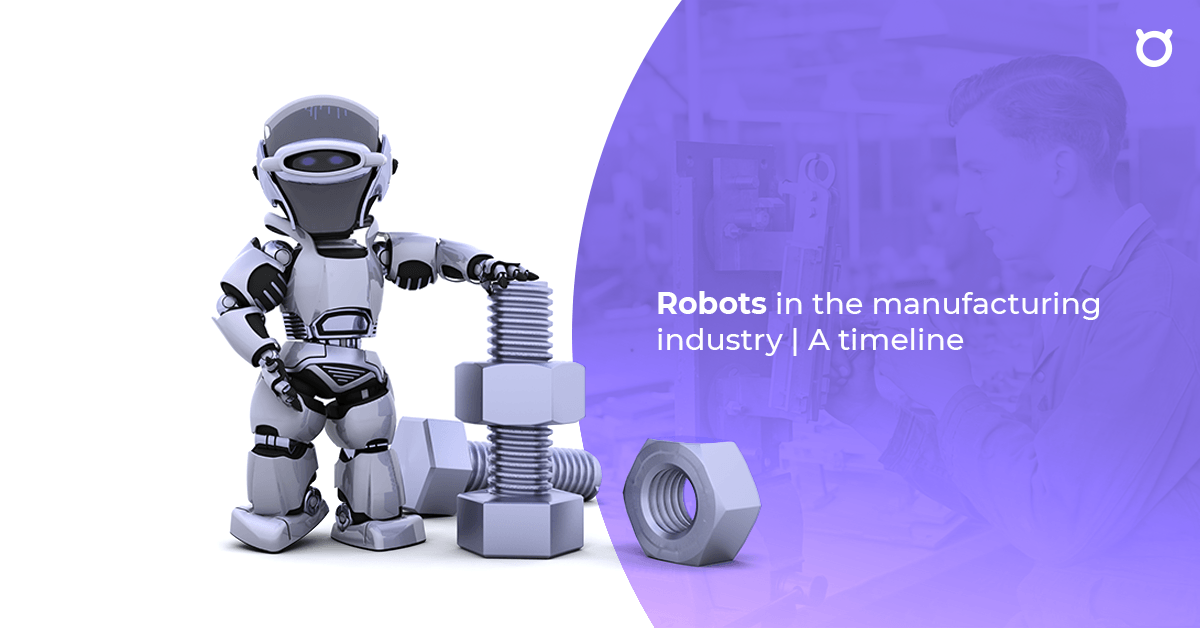Manufacturing is one of the most labor-intensive industries across the world. Tasks related to everything from ideation to production involve an investment of several human hours, in turn translating into high costs. The intensity and volume of operations in the manufacturing sector offered the perfect opportunity for automation to take its course. Enter, robots.#nbsp;
The introduction of robotics in manufacturing is an extension of today’s industrial revolution. Several redundant, undesirable operations that demanded human intervention only because of the lack of an alternative have become more efficient and time-saving. Manufacturing giants worldwide are leveraging robotic technologies and solutions to channel their capital into profit-making, critical functions within their operational life cycle.
This blog touches upon the inception, timeline, and dominance of robotics in the manufacturing sphere. Grab onto your devices as we take you on this stimulating journey of robots.
The Timeline
The first instance of robots entering the industrial workforce dates back to 1961, when General Motors deployed prototype robots to perform spot welding operations. Ford, the global automobile company, followed suit, and in 1969, Victor Scheinman created the Stanford Arm, a programmable six-jointed robot.
Sixty years since the initiation of industrial robots, several modifications and technologies later, its rise cannot be stinted. Today, robotic machines are joining the manufacturing workforce to work alongside human colleagues, build a productive work environment, save precious capital, and automate time-consuming tasks.
Why should you use robots in manufacturing?
The volley of robotic machines deployed in the manufacturing of different sizes makes, and capabilities is endless. So are their advantages. The below section will reiterate why robots can be ideal work partners for your manufacturing unit employees.
- Easily programmable: Robotics automation is reinventing the industrial sector with its conveniently programmable robots. Gone are the days when they could only function with the support of complex software programs. Today, modern robots can be programmed through offline programming, allowing developers to build the sequence of steps for a particular task carefully. Proven Robotics also offers a robot management system called PRoMS, which enables clients to use the Pepper robot immediately after purchase, without any tech expertise. Furthermore, organizations can create applications without any coding experience and instantly deploy them onto one or more robots.
- Job creation: Despite the constant assumption that robotic automation will take over human jobs, it is quite the opposite. Including robotics automation as part of the workforce will allow manufacturing business-owners to eliminate labor-intensive and monotonous tasks and create employment in sections such as engineering, robotics, and other associated fields.
- Save cost, time, and effort: Three essential components that urge an organizational unit towards success are capital, effort, and time investment. What if you could drive your firm towards success without spending too much of the components mentioned? This is what industrial robots help with. Not only can they be installed in record time, today, the cost and time involved in building them have also lowered significantly.
- Scale-up with robots: The upside of using robotics technologies in this sector is the adjustment in scalability. Modern robots can be scaled up or down based on the production value and volume of tasks associated with a manufacturing unit. This enables flexibility for stakeholders, allowing them to deploy multiple robotics machines only when necessary.
The most impactful example of robotics technologies in the manufacturing sector is the Tesla Gigafactory. They can perform a series of tasks, from body framing to hemming, all dedicated to the production unit.
While Spielberg’s portrayal of robotics technologies might not be completely spot-on, the bigger picture is quite similar. In fact, as we advance into the third decade of the 21st century, robotics automation is morphing into more than just physical machinery.
If you want to discover the depths of robotics software and its capabilities, follow us on Instagram, LinkedIn, and Facebook.
Drop us a line
Error: Contact form not found.




